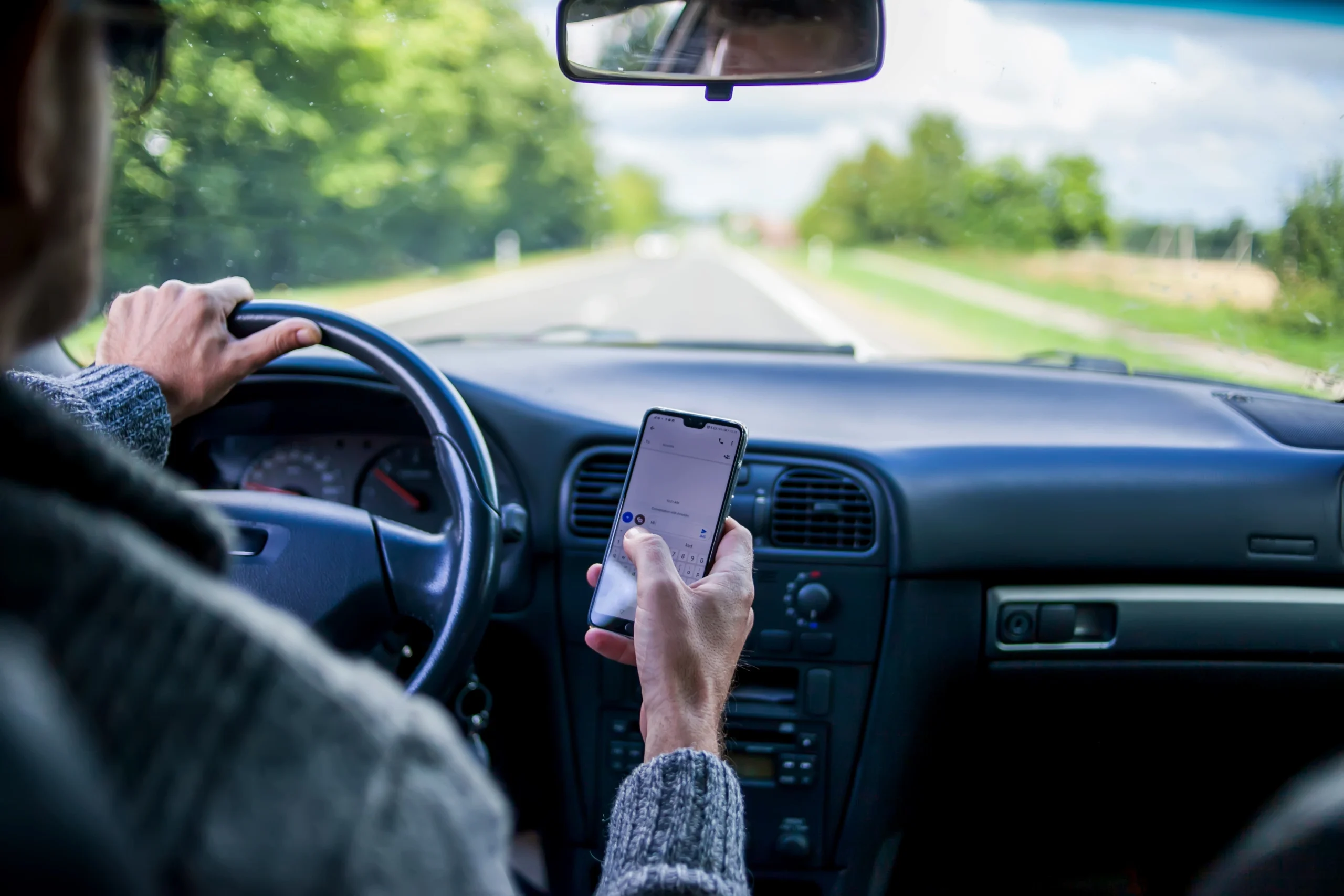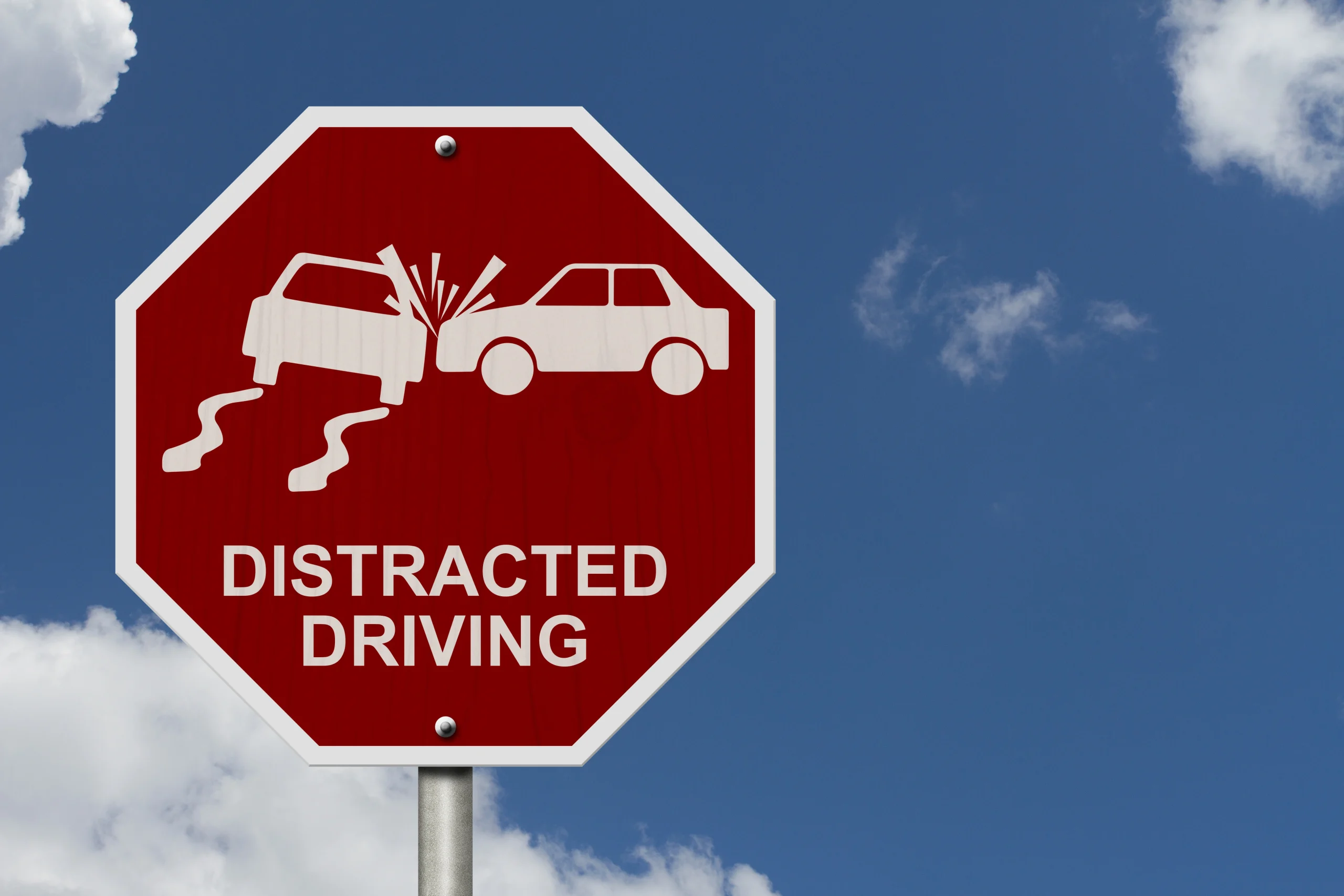Key Takeaways
RECENT POSTS
Categories
Stay Alert, Stay Alive: What is the Definition of Distracted Driving?
Key Takeaways
You never know when a distracted driving incident will strike. You could be on your way to work, school, or maybe just out running errands. As someone approaches a busy intersection, they hear the buzz of their phone as a new text message comes in. Without even thinking, they reach for their phone to check the notification as they begin to move through the intersection. In that split second, everything changes. They don't see the red light until it's too late, and before they know it, they've caused a horrific accident. All because of one moment of distraction. Distracted driving is a reality that we all need to acknowledge and address before it destroys more lives.
Distracted driving refers to any activity that diverts a driver's attention away from driving. This includes any form of multitasking behind the wheel, such as texting, using a phone, eating, applying makeup, adjusting the radio, or even daydreaming. Distracted driving can be further heightened when someone is under the influence of drugs or alcohol. It’s easy to see how drunk driving is incredibly dangerous, and by and large, people understand this danger (94% of Americans believe drunk driving is a serious safety issue). This dangerous behavior can have serious consequences, and it's up to all of us to recognize the risks and take action to prevent it.

so What is the Definition of Distracted Driving?
Distracted driving is any activity that could divert attention from the primary task of driving. The National Highway Traffic Safety Administration (NHTSA) defines distracted driving as any activity that takes a driver's attention away from the primary task of driving, such as visual, manual, or cognitive distractions. When a driver undertakes any activity that diverts attention away from driving, it puts their lives and others on the road at risk. Some of the most common instances of distracted driving include:
DRIVING WHILE TEXTING IS A CRASH RISK
Texting while driving, simply put, is one of the most dangerous things you can do while behind the wheel. When texting while driving, your attention is divided between the road and your phone. Your reaction time is slower and you become less aware of your surroundings, increasing the chances of a crash. According to the NHTSA, sending or reading a text takes your eyes off the road for about five seconds, which is enough time to travel the length of a football field at 55 mph. This can be devastating and it's crucial to prioritize safety over the urge to check your phone while behind the wheel.
In fact, research says texting while driving is at least twice as dangerous as drunk driving. Too much of your brain is occupied when you’re texting that there’s little room for processing the thousands of signals and stimuli coming from what’s in front of and all around you. In 2020, 3,142 people were killed in crashes involving distracted drivers. You cannot drive safely unless you are giving the task your full, undivided attention, meaning drivers should refrain from texting while driving at all costs.
DRIVING WHILE DROWSY
Research has shown that driving while drowsy can be just as debilitating as drunk driving. In fact, there are a lot of similarities between driving while intoxicated and driving while sleepy, such as slower reflexes, increased response times, and lower awareness of what’s going on around you. When you're tired, your reaction time is slower, and you're less alert and focused on the road. This can lead to poor decision-making, decreased coordination, and even falling asleep at the wheel.
According to the National Sleep Foundation, being awake for 18 hours straight can have the same effect on your driving as having a blood alcohol concentration of 0.05%, which is over the legal limit in many states. It's essential to prioritize getting enough rest before getting behind the wheel and take breaks and naps during long drives. One out of every six deaths from car accidents come from drowsy driving. In fact, studies have shown that driving after being awake for extended periods of time can be several times more dangerous than driving after having two drinks. If you’re sleepy, don’t get behind the wheel.
DRIVING WHILE USING HANDS-FREE TECHNOLOGY
Virtually every new car, truck, or SUV produced today has the ability to let you talk on your phone without using your hands. This development was applauded by safety advocates as being a less dangerous way to use your phone – but it’s still very dangerous. Many people assume that using hands-free technology while driving is safe, but it can still be a form of distracted driving. Even if your hands are on the wheel, your mind is still focused on the conversation or task at hand, taking your attention away from the road.
In fact, hands-free devices can be just as distracting as handheld ones. While hands-free technology may be a convenient way to stay connected on the road, it's important to remember that driving requires your full attention. If you must use hands-free technology, it's best to keep conversations short and focus on the road ahead. It goes back to your brain’s ability to focus and process. Studies have shown that using a hands-free device is still as distracting as texting or driving drunk. To that point, one study from the University of Utah found that when compared to hands-free drivers, drivers with a 0.08 BAC level actually drove better than people using hands-free technology and talking on the phone.

What are the most common injuries that result from distracted drivers?
Some of the most common injuries that result from distracted driving include:
Whiplash
The type of neck injury that occurs when the head is suddenly jerked back and forth. Symptoms can include neck pain, stiffness, headaches, and dizziness.
Fractures
The type of neck injury that occurs when the head is suddenly jerked back and forth. Symptoms can include neck pain, stiffness, headaches, and dizziness.
Head injuries
The type of neck injury that occurs when the head is suddenly jerked back and forth. Symptoms can include neck pain, stiffness, headaches, and dizziness.
Spinal cord injuries
These injuries occur when the spinal cord is damaged from a sudden impact or compression. Symptoms can include paralysis, loss of sensation, and difficulty breathing. Treatment may involve surgery, rehabilitation, or long-term medical care.
Soft tissue injuries
These include injuries to the body's muscles, tendons, or ligaments. In distracted driving accidents, these injuries can occur from sudden impact, jerking movements, or repetitive strain. Symptoms can include pain, swelling, stiffness, and limited mobility.
Fatalities
In severe distracted driving accidents, fatalities can occur as a result of the force of the collision or the position of the body during impact. Any activity that diverts attention from driving can lead to severe or fatal injuries.
It is extremely important to prioritize the practice of safe driving in order to prevent these severe injuries from occurring to yourself and others.
How can you prevent distraction while driving?
In order to prevent distracted driving, drivers can follow these precautions:
Make sure your cell phone is used for emergency situations only
Driving requires your full attention, and using your cell phone while behind the wheel can be a major distraction. To prevent accidents, keep your phone out of reach or set it to "Do Not Disturb" mode. Drivers should only use it in emergency situations, and always pull over to a safe location first.
Pull off the road if you are drowsy
Drivers feeling drowsy or fatigued while driving should pull off the road and take a break. Drowsy driving can impair your judgment and reaction time, making it dangerous to continue operating a vehicle.
Limit the numbers of activities inside the car and the number of passengers
Limiting the number of activities inside the car and the number of passengers is a smart way to prevent distractions while driving. The more passengers in the car, the more potential for conversation and noise that can divert a drivers' attention from the road. It only takes a split second of distraction to cause a serious accident.
Never eat while driving
Drivers eating while driving can be a major distraction, and it's best to avoid this activity altogether. Taking your hands off the wheel to handle food or drink, or looking down to pick up a dropped item can cause you to lose focus on the road ahead.
Do all multi-tasking before you begin your journey
Drivers should try to complete all of the necessary tasks, such as making phone calls, sending messages, or setting your GPS, before beginning their journey. That way, they can focus solely on driving and stay alert for any potential hazards or obstacles on the road.
If you have fallen victim to a drivers' distracted driving, then you should not hesitate to contact an attorney from Wettermark Keith today.
What are the legal consequences of these distractions?
Driving while impaired – whether it’s because you’re intoxicated or you’re distracted – results in tens of thousands of injuries and fatalities each year. Your brain simply can’t do everything at once and it only takes a split second for an accident to occur.
Distracted driving has serious legal consequences. In most jurisdictions, it is illegal to engage in distracting activities, such as texting, using a handheld device, or eating while behind the wheel. If a driver is caught engaging in these activities, they may be issued a citation and have to pay a fine. Distracted driving violations may also cause a driver’s insurance premiums to increase or lead to license suspension or revocation. If this driver causes an accident, they may be held liable for any damages or injuries that result from the crash. This could include paying for medical bills, property damage, and lost wages. For individuals who drive as a part of their job, a distracted driving accident could also result in termination of employment. Depending on the severity of the accident, the distracted driver may also face criminal charges, such as reckless driving or vehicular manslaughter.
Overall, distracted driving can have serious consequences. Drivers need to stay focused and avoid distractions to prevent accidents and protect themselves from legal liability. So, don’t drink and then drive or drive while intoxicated at any level. Don’t text while driving. Don’t step behind the wheel of a car when you’re sleepy or drowsy. And don’t use your phone at all while driving if you can help it – even if it’s hands-free. If we all followed these safety precautions, the roads would be much safer for all of us.
WETTERMARK KEITH: DISTRACTED DRIVING ATTORNEYS
Dealing with the aftermath of a distracted driving incident can be a scary experience. At Wettermark Keith, our lawyers are passionate about their work. While investigating your traffic incident and injuries, our car accident attorneys and their associates will gather evidence and seek to bring about legal justice for you or your loved one. Wettermark Keith, with offices located throughout Alabama, Tennessee, and Florida, has an excellent reputation as one of the most accomplished personal injury firms in the country. Wettermark Keith’s reach is not only regional, but it also includes a diverse range of practice areas, including car accident lawyers.
We believe in taking cases personally. Our purpose is to practice with care and compassion- to tell our clients’ stories and make their voices heard. We do this by building strong relationships based on constant communication and an unwavering dedication to truth and trust. You should never wonder what’s going on with your case. Our firm will keep you in the loop and represent you as if you are family- because to us, you are.
At Wettermark Keith, we provide legal consultation and service to those who have been seriously injured at the hands of another, especially while on the road. If you have been a victim of a motor vehicle accident, contact our personal injury lawyers for a free consultation.
Frequently Asked Questions
Distracted driving impact refers to the negative effects that distracted driving can have on the driver, passengers, other motorists, pedestrians, and property. It includes the physical, emotional, and financial consequences that can result from a distracted driving accident.
The consequences of distracted driving can include property damage, personal injury, and even death. In addition to the human toll, distracted driving can also result in legal consequences, such as fines and criminal charges, as well as increased insurance premiums.
According to the National Highway Traffic Safety Administration (NHTSA), in 2021, distracted driving was a factor in 9% of fatal crashes in the United States, resulting in 3,522 deaths. Using a cell phone while driving increases the likelihood for deaths and injuries on U.S. roads, and it is one of the most common distracted driving incidents. The most concerning form of distraction is texting; when sending or reading a text, your eyes are diverted from the road for 5 seconds. If you are traveling at 55 mph, that equates to driving the entire length of a football field while keeping your eyes shut.
The different types of distracted driving can be categorized into three main types: visual, manual, and cognitive. Visual distractions take the driver's eyes off the road, manual distractions take the driver's hands off the wheel, and cognitive distractions take the driver's mind off driving.
According to a recent study, 25 to 34 year olds are involved in the most distracted driving fatalities. In 2020, there were 729 drivers between the ages of 25 and 34 involved in a fatal accident. The next most common group involved were people between the ages of 35 and 44. Teens actually only account for 6% of these incidents.
Ready to work together? Contact us today for a free consultation.
HERE'S WHAT TO DO NEXT
If you or a loved one have been injured and think you might have a case, call us now for a free consultation.


